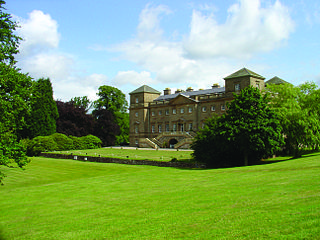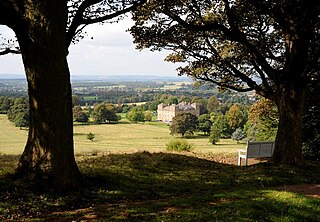
Worcestershire is a ceremonial county in the West Midlands of England. It is bordered by Shropshire, Staffordshire, and the West Midlands county to the north, Warwickshire to the east, Gloucestershire to the south, and Herefordshire to the west. The city of Worcester is the largest settlement and the county town.

The Stour(, rhymes with "flour") is a river flowing through the counties of Worcestershire, the West Midlands and Staffordshire in the West Midlands region of England. The Stour is a major tributary of the River Severn, and is about 25 miles (40 km) in length. It has played a considerable part in the economic history of the region.

The Clent Hills lie 10 miles (16 km) south-west of Birmingham city centre in Clent, Worcestershire, England. The closest towns are Stourbridge and Halesowen, both in the West Midlands conurbation. The Clent Hills range consists of, in order from north-west to south-east: Wychbury Hill, Clent Hill, and Walton Hill. The north Worcestershire range of hills continues eastwards to include Romsley Hill, Waseley Hills and the Lickey Hills.

Wychbury Hill is a hill situated off the A456 Birmingham Road, at Hagley, Stourbridge, on the border of West Midlands and Worcestershire.

The Hagley Obelisk stands close to the summit of Wychbury Hill in Hagley, Worcestershire, approximately 150 metres (490 ft) from the border with the West Midlands. Visible for miles around, and accessible from public footpaths, it was for a while connected with a murder victim discovered on the nearby Lyttelton estate.

Hagley Hall is a Grade I listed 18th-century house in Hagley, Worcestershire, the home of the Lyttelton family. It was the creation of George, 1st Lord Lyttelton (1709–1773), secretary to Frederick, Prince of Wales, poet and man of letters and briefly Chancellor of the Exchequer. Before the death of his father in 1751, he began to landscape the grounds in the new Picturesque style, and between 1754 and 1760 it was he who was responsible for the building of the Neo-Palladian house that survives to this day.

Known as the Hagley Road in Birmingham, the A456 is a main road in England running between Central Birmingham and Woofferton, Shropshire, south of Ludlow. Some sections of the route, for example Edgbaston near Bearwood, are also the route of the Elan Aqueduct which carries Birmingham's water supply from the Elan Valley.

Blakedown is a village in the Wyre Forest District lying along the A456 in the north of the county of Worcestershire, England. Following enclosures and the arrival of the railway, it developed both agriculturally and industrially during the 19th century. Due to its transport links, it now serves mainly as a dormitory for the neighbouring town of Kidderminster and for the cities of Birmingham and Worcester.

Blakedown railway station serves the English village of Blakedown, Worcestershire. It was opened as Churchill in 1852, later becoming known for a time as Churchill & Blakedown after the two villages became a single parish.

Hagley railway station serves the English village of Hagley, Worcestershire. Trains call in each direction, running to or through Kidderminster westwards and through Stourbridge and Birmingham Snow Hill eastwards. Customer Information Screens are installed on either platform. All services are operated by West Midlands Trains.
Wordsley is a suburban area of Stourbridge in the West Midlands, England. It is part of the Metropolitan Borough of Dudley and falls into the Stourbridge (DY8) postcode and address area, being just north of the River Stour. Wordsley is part of the Kingswinford and South Staffordshire Parliamentary constituency as of 2024. It is bordered by open Staffordshire countryside to the west, Kingswinford to the North, Brierley Hill to the East and Stourbridge to the South.

Belbroughton is a village and civil parish in the Bromsgrove District of Worcestershire, England. According to the 2021 census it had a population of 2,685. It is about six miles north of Bromsgrove, six miles east of Kidderminster and four miles south of Stourbridge. The village of Clent is nearby. The village is served by bus service 318 (Bromsgrove-Stourbridge) operared by Kev's Cars and Coaches.

Broome is a village and civil parish in the Wyre Forest District of Worcestershire, England. According to the 2001 census it had a population of 338. The village is situated on the lower slopes of the Clent Hills and lies to one side of Broome Lane, a minor road that runs westwards from the outskirts of Clent to the outskirts of Hagley.

The Birmingham to Worcester via Kidderminster line is a railway line which runs from Birmingham Snow Hill to Worcester via Stourbridge and Kidderminster in the West Midlands, England. It is one of the Snow Hill Lines, with trains operated by West Midlands Trains and Chiltern Railways using a variety of rolling stock including Class 172 and Class 168 diesel units. It is a future aspiration of Network Rail to electrify the entire line, as well as the Chiltern Main Line to London Marylebone.
Oldswinford or Old Swinford is an area south of the centre of Stourbridge, West Midlands, England, which takes its name from a civil parish abolished in 1866.

Cradley is a village in the Black Country and Metropolitan Borough of Dudley near Halesowen and the banks of the River Stour. Colley Gate is the name of the short road in the centre of Cradley. It was part of the ancient parish of Halesowen, but unlike much of the rest of that parish, which was an exclave of Shropshire, Cradley was always in Worcestershire, until the creation of the West Midlands county in 1974. This meant that for civil administrative purposes, Cradley formerly had the officers which a parish would have had. The population of the appropriate Dudley Ward taken at the 2011 census was 13,340.

The A491 is an A road in Zone 4 of the Great Britain numbering scheme.

Clent is a village and civil parish in the Bromsgrove District of Worcestershire, England, southwest of Birmingham and close to the edge of the West Midlands conurbation. At the 2001 census it had a population of 2,600.
Celestino Enrico Pancheri was an Italian sculptor and carver who worked in Bromsgrove, Worcestershire.

Hagley Park is the estate of Hagley Hall in Worcestershire, England. The grounds comprise 350 acres (1.4 km2) of undulating deer park on the lower slopes of the Clent Hills. They were redeveloped and landscaped between about 1739 and 1764, with follies designed by John Pitt, Thomas Pitt, James "Athenian" Stuart, and Sanderson Miller. Planned as part of an 18th-century enthusiasm for landscape gardening, especially among poets, the park brought many distinguished literary visitors to admire the views, as well as poetic tributes to their beauty and Classical taste.




















